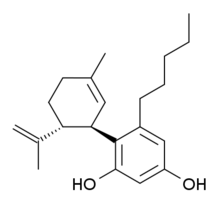Chemistry:Abnormal cannabidiol
 | |
 | |
| Identifiers | |
|---|---|
| |
| CAS Number | |
| PubChem CID | |
| ChemSpider | |
| UNII | |
| Chemical and physical data | |
| Formula | C21H30O2 |
| Molar mass | 314.46 g·mol−1 |
| 3D model (JSmol) | |
| |
| |
| | |
Abnormal cannabidiol (Abn-CBD) is a synthetic regioisomer of cannabidiol, which unlike most other cannabinoids produces vasodilator effects, lowers blood pressure, and induces cell migration, cell proliferation and mitogen-activated protein kinase activation in microglia, but without producing any psychoactive effects.[1][2]
Receptor activity
It has been shown that the actions of abnormal cannabidiol are mediated through a site separate from the CB1 and CB2 receptors,[2][3] which responds to abnormal cannabidiol, O-1602, and the endogenous ligands: anandamide (AEA), N-arachidonoyl glycine (NAGly) and N-arachidonoyl L-serine.[2][4][5][6] Multiple lines of evidence support the proposed identification of this novel target in microglia as the previously "orphan" receptor GPR18.[2] Another possible target of abnormal cannabidiol is GPR55, which has also received much attention as a putative cannabinoid receptor,[7][8] although a growing body of evidence points to lysophosphatidylinositol (LPI) as the endogenous ligand for GPR55.[9][10] Further research suggests there are yet more additional cannabinoid receptors.[11][12][13][14]
Pharmacodynamics
Research of the effects on abnormal cannabidiol in mice has indicated that atypical cannabinoids have therapeutic potential in a variety of inflammatory conditions, including those of the gastrointestinal tract. After inducing colitis by means of trinitrobenzene sulfonic acid, wound healing of both human umbilical vein endothelial and epithelial cells was enhanced by the Abn-CBD.[15]
See also
- Cannabinoids
- Cannabinoid receptors
- Delta-6-Cannabidiol
- O-1918
- Rimonabant
References
- ↑ "A cannabinoid with cardiovascular activity but no overt behavioral effects". Experientia 33 (9): 1204–1205. September 1977. doi:10.1007/BF01922330. PMID 891878.
- ↑ 2.0 2.1 2.2 2.3 "N-arachidonoyl glycine, an abundant endogenous lipid, potently drives directed cellular migration through GPR18, the putative abnormal cannabidiol receptor". BMC Neuroscience 11: 44. March 2010. doi:10.1186/1471-2202-11-44. PMID 20346144.
- ↑ "Cannabinoid-induced mesenteric vasodilation through an endothelial site distinct from CB1 or CB2 receptors". Proceedings of the National Academy of Sciences of the United States of America 96 (24): 14136–14141. November 1999. doi:10.1073/pnas.96.24.14136. PMID 10570211. Bibcode: 1999PNAS...9614136J.
- ↑ "Nonpsychotropic cannabinoid receptors regulate microglial cell migration". The Journal of Neuroscience 23 (4): 1398–1405. February 2003. doi:10.1523/JNEUROSCI.23-04-01398.2003. PMID 12598628.
- ↑ "Selective ligands and cellular effectors of a G protein-coupled endothelial cannabinoid receptor". Molecular Pharmacology 63 (3): 699–705. March 2003. doi:10.1124/mol.63.3.699. PMID 12606780.
- ↑ "N-arachidonoyl L-serine, an endocannabinoid-like brain constituent with vasodilatory properties". Proceedings of the National Academy of Sciences of the United States of America 103 (7): 2428–2433. February 2006. doi:10.1073/pnas.0510676103. PMID 16467152. Bibcode: 2006PNAS..103.2428M.
- ↑ "Anandamide-mediated CB1/CB2 cannabinoid receptor--independent nitric oxide production in rabbit aortic endothelial cells". The Journal of Pharmacology and Experimental Therapeutics 321 (3): 930–937. June 2007. doi:10.1124/jpet.106.117549. PMID 17379772.
- ↑ "The orphan receptor GPR55 is a novel cannabinoid receptor". British Journal of Pharmacology 152 (7): 1092–1101. December 2007. doi:10.1038/sj.bjp.0707460. PMID 17876302.
- ↑ "Atypical responsiveness of the orphan receptor GPR55 to cannabinoid ligands". The Journal of Biological Chemistry 284 (43): 29817–29827. October 2009. doi:10.1074/jbc.M109.050187. PMID 19723626.
- ↑ "The GPR55 ligand L-alpha-lysophosphatidylinositol promotes RhoA-dependent Ca2+ signaling and NFAT activation". FASEB Journal 23 (1): 183–193. January 2009. doi:10.1096/fj.08-108670. PMID 18757503.
- ↑ "Novel cannabinoid receptors". British Journal of Pharmacology 152 (5): 567–575. November 2007. doi:10.1038/sj.bjp.0707481. PMID 17906678.
- ↑ "The novel endocannabinoid receptor GPR55 is activated by atypical cannabinoids but does not mediate their vasodilator effects". British Journal of Pharmacology 152 (5): 825–831. November 2007. doi:10.1038/sj.bjp.0707419. PMID 17704827.
- ↑ "Inhibition of human neutrophil chemotaxis by endogenous cannabinoids and phytocannabinoids: evidence for a site distinct from CB1 and CB2". Molecular Pharmacology 73 (2): 441–450. February 2008. doi:10.1124/mol.107.041863. PMID 17965195.
- ↑ "2-Arachidonoylglycerol elicits neuroprotective effects on excitotoxically lesioned dentate gyrus granule cells via abnormal-cannabidiol-sensitive receptors on microglial cells". Glia 57 (3): 286–294. February 2009. doi:10.1002/glia.20756. PMID 18837048.
- ↑ "Abnormal cannabidiol attenuates experimental colitis in mice, promotes wound healing and inhibits neutrophil recruitment". Journal of Inflammation 13 (21): 21. 2016. doi:10.1186/s12950-016-0129-0. PMID 27418880.
 |
